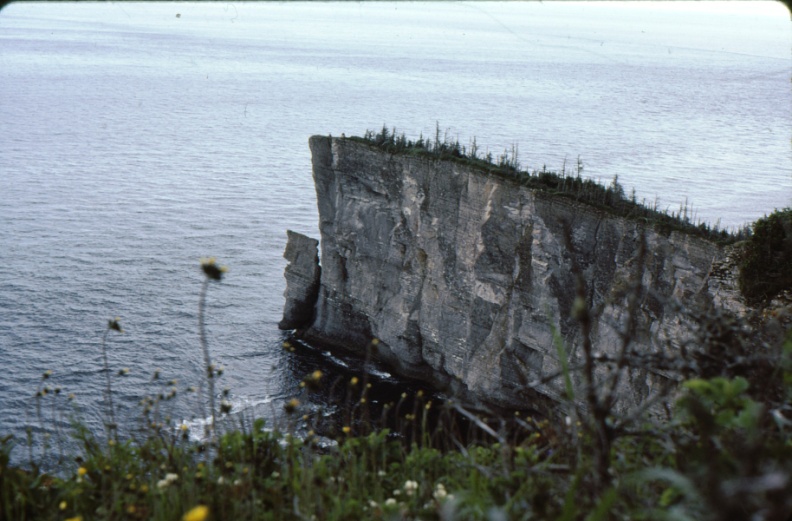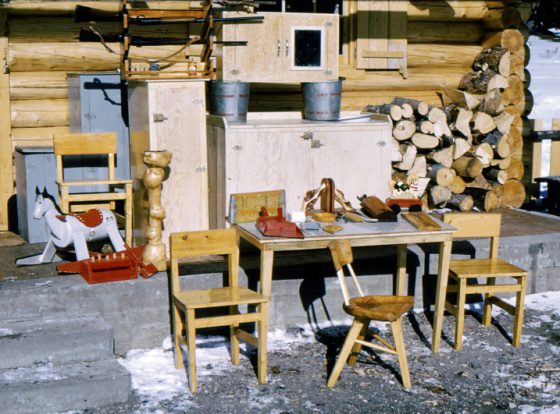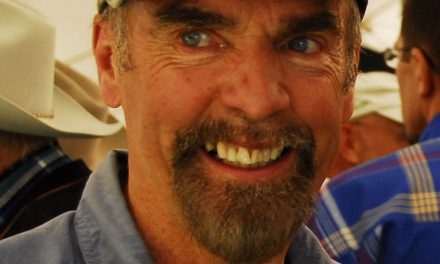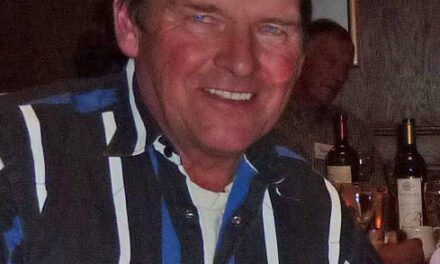There was a possibility of an opening in Waterton and a few other places. I didn’t get Waterton but we were offered Sinclair Canyon district in Kootenay National Park. The warden station isn’t there anymore today, but it was down near the tunnel and the acquacourt. We stayed in Kootenay for four years, we quite enjoyed it. That was the time of the Sime-Schuler Report…It was a study of the future of the warden service. They decided that wardens needed to have more education and to be responsible for a much greater part of resource management within the parks. Several people, Gerry Campbell, Ron Langevin, Andy Anderson and I went to Hinton, to the Forestry Technology School and became forestry technicians in the process. We were selected to go to this school and actually receive a promotion without competition. I think this was only held once. Andy was offered the chief park warden job in Yoho and I was offered the Assistant Chief Warden job in Jasper. I went to Jasper for two years as the Assistant Chief Warden and that was just when the district system changed to the area system, or centralization. In Banff, centralization was just a year or two earlier. Jasper and Riding Mountain really resisted that thing and so in Jasper it wasn’t done until Mickey retired because he was very strongly against it. Jasper was then divided into five areas, which eventually became four areas. I had the town area, the largest area and probably two thirds of the Jasper wardens were working under my supervision. Then a chief warden position came open so we went to Waterton and we were there for fifteen years, except for the one year we had in Quebec where we went on an exchange with Gaby Fortin.
Julie – We exchanged houses.

Max – That was in the Gaspe. We were in Forillon National Park.
Julie – Max spoke about 50 words of French before going there.
Max – I knew your father (Keith Everts)…I was in Rogers Pass quite a bit with him. When I was at Kootenay they had a program in which they were going to send wardens to Glacier from different parks to be working three weeks with Freddy Schleiss (on avalanche forecasting and control) and three weeks with the wardens on the highway (at Rogers Pass) but it didn’t work out. I think it was an excellent system but it didn’t work out the way they had hoped.
Max – I retired in 1987 May 19, 1987.

Max – Like many people, I guess, we had to live in government housing. But then when the rents became quite high (probably in Banff the rents were the highest), some of the wardens said, “Well, I will buy my own house.” Eventually they were allowed to actually live outside the park. That was when a lot of people moved to Canmore and Harvie Heights. We never lived outside the park when I was working except for the last few month before retirement. But we had the same idea as other wardens so we bought a farm, a quarter section just half way between Waterton Park and Pincher Creek. We didn’t live there until the house was ready in 1986. We lived there from the late fall 1986 until I retired in the spring of 1987. For four months I commuted. We still are living at the farm. We had cattle for a while. We had purebred Herefords. We live there now just in the summertime. Just a week ago we moved in to Pincher Creek.
Julie – We had a couple of saddle horses along with the cattle but we don’t have any livestock now.
Max – We are 80 years old now, you know. Julie has more hobbies than I have.
Julie – I was a woodcarver for 45 years. That was my only source of income when we were out in the bush and I continued with it when we moved to various warden stations. At one time I had as many as seven stores selling my work in Alberta, Saskatchewan and B.C. I was a pretty well self taught carver through books and experience. Toni Klettl started woodcarving at about the same time. Much of his work was in carving animals…mountain sheep, goats, bears and cougars but I carved a great variety of things, too numerous to mention. I used to be called “The Mushroom Lady” because I carved a lot of mushrooms. We moved out to the Brazeau district in 1960 and it was in the following year that I began to carve. Also I wanted to build some kind of musical instrument that could be run by a water wheel. I tried filling bottles with water as I knew different tones could be produced by striking them when each was filled with different amounts of water. I had to give that up as there were not enough bottles around. Then a friend in Edmonton came to visit us and first she asked if there was something she could bring. I asked for a little xylophone and when, with Max, she rode the 18 miles to our cabin she brought one which was perfect for my use. First I built a raft, then a water wheel to be mounted on the back end of the raft which was anchored in the creek. A large drum was built next and on it I placed little pegs. The drum was rigged to be rotated by the water wheel and the pegs were so placed that they tripped a series of levers above the keys of the xylophone which was mounted on the deck of the raft. The levers were tipped with empty .303 cartridges so it would be metal striking the metal keys.

That was the summer that a crew of eight men came to build the new Brazeau cabin. They were there for the whole summer, the crew, their cook and two packers for the string of 15 horses that packed in all the necessary supplies. Art Allen was the building foreman and as he was interested I would often consult with him about my various construction problems. We would spend evenings in discussion because it was not a simple job without the use of a lathe or other electric tools. It was all done with a hand saw, an axe, a draw knife, a plane and a jack knife, the tools that were available. Finally it was finished just before the crew left. Not yet in the water but set up on sawhorses, I could twirl the water wheel and hear music on the xylophone. The first tune it played was Home Sweet Home.” I couldn’t read the music book that came with the instrument so I had to figure out how to place the pegs by math. To my ear the tune was perfect. In the fall I took it out of the river and leaned it against a tree for over winter. One time when Max was away I saw a bear swatting at it with his claws. I had a shotgun in case the cabin was ever invaded by a bear so I fired over the bear’s head. He wasn’t very frightened but he did leave. Later, I figured out that he had been attracted by the bacon fat I had used to grease the axels. That was my biggest project, my claim to fame. It felt like I was launching the Queen Mary when first I put it in the river. When we moved to Jacques Lake we took the water wheel but left the raft. When twenty years later, with Terry, we rode around the south boundary the raft was still lying beside the creek. I have written this story in my little book, “Having Fun with Necessity’s Mom.” Do you know who is the mother of necessity? Invention! I’ve had fun with all my little inventions.
Max – One of the challenges for us was that we had no power tools or electricity. So when we went to the Brazeau neither of us was a carpenter but we needed furniture. The first thing that was important to us was a crib because we had only the baby buggy that I had packed in. That was stupid to have a baby buggy twenty miles off the highway!
Julie – I would hitch the dog to it and, with the baby aboard, we would go bumping across the meadow.
Max – But we built this crib and made it so we could take it apart and pack it on a horse to the next district because we knew that we would move again. All the stuff that we built was made from dead trees. I squared the wood off with an axe, then planed it down and we made a baby’s bed out of it. For a spring we used fire hose.
Julie – I used lengths of old fire hose and they were woven into a spring, then I made a make-shift mattress for it.
Max – On that first district, the Brazeau, there wasn’t one chair, or one place to sit with a backrest on it. There were only benches and you know how you get kind of tired when you can’t lean against anything. So we made three chairs. In the old cabin, the floor was very uneven. Julie made a three legged chair because then it wouldn’t rock. Together we made several of these other pieces of furniture, a table, a writing desk, and a shelving unit for toilet articles. We made a place for all the dish washing stuff underneath, a gun rack, and storage for firewood. There were seven cabin signs that Julie carved. Actually we carved some together. Each sign had the name of the cabin and the picture of some wildlife such as a deer, sheep, cougar or bear. They are still there right now on the various cabins. We did the same thing on the next district.


Julie – People often say,” Your signs are still up there on those two districts, Julie.”
Max – Ursula and Terry (Max and Julie’s daughter-in-law and son) were actually stationed in the present day on the Brazeau for two summers…They weren’t there year round like we were. But they were there in the same place with our grandson, Peter.
Max – The mountains and the way of life were the reasons why I wanted to get on with the warden service. I have to admit, when I started to go to Jasper and places like Elk Island where we went a lot, I didn’t know much about national parks. The fact that a national park has something that is well worth preserving and that you have a part in this preservation and conservation was something that grew in my mind, rather than having that knowledge when I first came into the service. Nowadays, the young people that get into the warden service come in with a greater understanding of what national parks are all about and what they ought to be. And also what their responsibility is within the system. For us it took a number of years to get to this point. There probably were various degrees of understanding. Julie and I consider ourselves to be environmentalists and avid proponents of national parks. We certainly are not alone. I know Mac Elder and a great many old timers are in the same boat.
Max – In eighty years of living you do change and adapt to things. Initially what I liked best about being a warden was the rugged outdoor work and the life that you had and the challenge of it. I think that is where Julie and I succeeded. We managed to get along and adapt to the challenges. Julie, I think, often had to follow me but she willingly followed me into some of these new adventures and I think that what we did was make the best of what we could in every situation. Like some people we know, they regret the past or they haven’t yet reached the future but they don’t enjoy the present. I think we were largely able to enjoy the present. Even our son says, “I don’t know how you had the guts to go down to Quebec.” I wanted to learn French. I wanted to learn the French way of life and culture. I didn’t succeed in learning French the way I would have liked to but I can make a conversation, a limited conversation in French. I am studying French this winter. Canada in this way is such a rich, rich country, a beautiful country and while you wouldn’t want to live in just any old place, to visit some of these places and get to know them is really, I think, a wonderful experience. I have been fortunate enough that Julie has supported me. I mean she did not initially want to go to Quebec. She didn’t even want to go to Kootenay and neither one of us wanted to return to Jasper where, all of a sudden, I was the supervisor of many of the people who had far more seniority and experience than I did. Yet we were accepted. Both times in Jasper were wonderful experiences.



